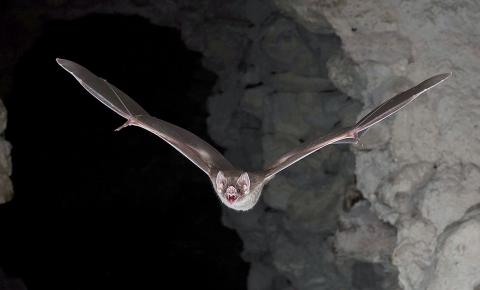If you want to know how vampire bats can survive on a diet that — as everyone knows — consists exclusively of blood, the answer is simple. It’s in their genes.
Scientists on Monday said they have mapped for the first time the complete genome of a vampire bat, finding that this flying mammal boasts numerous genetic traits that help it thrive on an exotic food source that offers nutritional disadvantages and exposes it to blood-borne pathogens.
The researchers compared the genome of the common vampire bat, scientific name Desmodus rotundus, to genomes of bat species that eat nectar, fruit, insects and meat. They also examined microbial DNA from its droppings.

Photo: AFP
照片:法新社
This bat and the world’s two other vampire bat species, the hairy-legged vampire bat and the white-winged vampire bat, are the only mammals that eat just blood.
The common vampire bat, a nocturnal cave-dweller with an 18 cm wingspan, inhabits parts of Mexico, Central America and South America. It feeds on the blood of livestock such as cattle and horses. It lands near prey under cover of darkness, walks on the ground, then feeds on the sleeping animal using razor-sharp teeth to pierce the skin and a lengthy tongue to lap up flowing blood.
“We decided to study this species because it has an ‘extreme’ diet, in the sense that it requires many adaptations in the organism to live on that,” said study lead author Lisandra Zepeda, a University of Copenhagen doctoral student while doing the research published in the journal Nature Ecology & Evolution. “Blood is a challenging dietary source since it provides very low levels of vitamins and carbs, and a lot of proteins, salts and waste products.”
They pinpointed genome elements that augment the bat’s immune response and viral defense to cope with pathogens lurking in blood. They also identified genes involved in the metabolism of vitamins and fats that could help the bat deal with the unique nutritional aspects of its blood diet.
To some people, vampire bats are creatures of dread, associated with fictional vampires like Dracula.
“Yeah, they’re messed-up creatures, or amazing creatures, whatever you want to call them,” Zepeda said. “My personal feelings about them is that it’s too bad people demonize them like that. We should be amazed by them, not scared. They’re actually quite cute: Abstract beauty. Sure, you don’t want them to bite your cows if you’re a farmer, but they were there way before you.” (Reuters)
如果你想知道吸血蝙蝠如何只靠一種眾所皆知的特殊飲食習慣──飲血──存活,答案很簡單,就在牠們的基因裡。
上週一,科學家宣布首次完成吸血蝙蝠的完整基因體圖譜繪製,並發現這類飛行哺乳動物擁有數種基因特徵,能幫助牠們只靠這種風味特殊的食物就能成長茁壯。血液僅提供不均衡的營養價值,還會讓吸血蝙蝠暴露於血源性病原體的風險中。
研究人員將普通吸血蝠(學名為Desmodus rotundus)的基因體拿來和吸食花蜜、吃水果、攝食昆蟲和肉類等其他種類蝙蝠的基因體互相對照。他們同時也檢驗吸血蝠糞便裡面的微生物去氧核醣核酸。
普通吸血蝠,以及另外兩種吸血蝠──毛腿吸血蝠與白翼吸血蝠──是世界上唯一只靠嗜血維生的哺乳類動物。
普通吸血蝠是夜行性的穴居動物,翼長十八公分,棲息於墨西哥、中美洲,以及南美洲等地,攝取牛和馬等家畜的血液維生。在夜色的庇護下,吸血蝠悄悄地降臨到獵物附近,在地上行走,然後趁獵物熟睡時,用剃刀般銳利的牙齒刺穿牠們的皮膚,再用長長的舌頭貪婪地舔食著泊泊流出的血液。
這份研究的主要作者是哥本哈根大學的博士生莉珊德拉‧策佩達,研究成果日前發表在學術期刊《自然─生態與演化》上。策佩達指出;「我們決定研究這個物種的原因,是因為它們有著極端的飲食習慣。意思是說,這種飲食其實需要生物體內的許多適應機制才能賴以維生。」她解釋說:「血液其實是一種問題重重的食物來源,因為其中的維生素與碳水化合物含量極低,同時卻又充滿太多蛋白質、鹽份,以及廢棄物質。」
這群研究人員在吸血蝠的基因體裡,精確地找出能夠增強蝙蝠免疫反應與病毒抵抗力的特殊基因物質,讓牠們能夠對付獵物血液裡潛藏的病原體。研究人員同時也辨識出吸血蝠體內參與維生素與脂肪新陳代謝的基因,讓蝙蝠得以應付單純攝取血液導致的獨特營養問題。
對一些人而言,吸血蝠是恐怖的生物,不禁讓人聯想到吸血鬼德古拉這類虛構的人物。
「是啊,牠們是相當糟糕的生物,也可以是讓人驚嘆的生物,端看你想怎麼說,」策佩達這麼說。「我個人對牠們的感覺是,人們將這種生物妖魔化是相當可惜的一件事。我們應該要對吸血蝙蝠的獨特性感到驚嘆,而不是感到害怕。其實牠們真的還滿可愛的,我想是一種抽象的美吧。當然,如果你是農場的主人,你絕對不會希望牠們來咬你養的牛,但這些蝙蝠其實早在你蓋農場之前就已經存在那裡很久了。」
(台北時報章厚明編譯)

A: The news says comic superstar Snoopy’s birthday is coming soon on Aug. 10. B: So he’s a Leo, and his birthday will fall on this Sunday. A: Cartoonist Charles Schulz created the comic strip Peanuts, featuring Snoopy, in 1950. And this year marks the character’s 75th anniversary. B: No wonder there are some big celebrations in Japan, Hong Kong and elsewhere. How about Taiwan? A: The “How Do You Do, Snoopy?” exhibition is taking place in Taipei. Let’s go to Shin Kong Mitsukoshi Department Store’s A11 branch to see the show. A: 新聞說,卡通巨星史努比的生日是8月10日耶。 B: 原來史努比是獅子座,本週日就是他的生日。 A: 漫畫家查爾斯舒茲1950年在《花生》漫畫創造了該角色,今年正好歡慶75週年! B:

When you think of the Netherlands, images of tulips, windmills, and iconic wooden shoes — known as “Dutch clogs” — may come to mind. These traditional shoes are rich in cultural significance. For centuries, Dutch clogs have been admired for their sturdy design and impressive craftsmanship, making them a fascinating symbol of Dutch heritage. Dutch clogs date back to the Middle Ages. During that time, farmers and laborers needed durable shoes to cope with the region’s damp and unpredictable climate and topography. Crafted from solid wood, such as willow or poplar, clogs offered outstanding protection. Their firm structure kept

Bilingual Story is a fictionalized account. 雙語故事部分內容純屬虛構。 “One DA-BEI... WU LONG... NAI?” Yujing smiled as the foreigner struggled to order. He looked like an embarrassed puppy. She repeated the order in Chinese, then English: “Oolong milk tea, large size. Half sweet, no ice?” she said gently. He beamed — the kind of full-face, sunshine smile that Latinos are famous for. “Yes! That! You are... lo maximo… the best!” After he left, Lily nudged her. “Nice save. You’re getting the hang of it.” Yujing had taken this summer job at the bubble tea shop to build confidence and get work

A: Apart from the “How Do You Do, Snoopy?” exhibition, the Penghu International Fireworks Festival displayed some Snoopy-themed balloon installation art. B: The Yilan International Children’s Folklore & Folkgame Festival also displayed a giant rubber “Snoopy Duck.” A: And Starbucks, Kura Sushi and 7-Eleven are all selling Snoopy-themed products. B: Starlux Airlines even launched new Snoopy-themed flights recently. Isn’t that cool? A: Taiwanese love Snoopy so much. Happy 75th birthday, Snoopy. A: 除了《How Do You Do, Snoopy?花生漫畫75週年特展》,澎湖海上花火節展出了史努比氣球裝置藝術。 B: 而宜蘭國際童玩藝術節,則展出了巨型「史努比鴨」。 A: 星巴克、藏壽司、7-Eleven也推出了史努比聯名商品。 B: 星宇航空今年更推出全新「Snoopy主題航班」,很酷吧? A: 台灣人好愛史努比啊,75歲生日快樂!